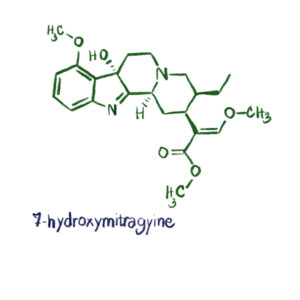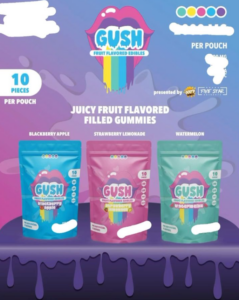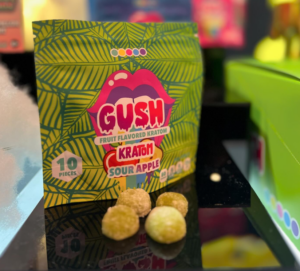
Your Really Goo’d Guide to 7-HYDROXY
7-HYDROXY, also known as 7-Hydroxymitragynine (7-OH), is a naturally occurring alkaloid found in the leaves of the Mitragyna speciosa tree (commonly known
Live resin has become synonymous with higher-grade cannabis products, and a lot of people who indulge it know little more than the fact that the effects of live resin seem to hit them a lot stronger. Well, for anyone wondering, we want to dive deeper into the world of live resin, by explaining what it is, how it’s made, and why so many people never go back once they make the switch.
Live resin is a type of full-spectrum cannabis extract, and the difference between live resin and the more traditional type of extract (now referred to as “dry resin”) is that it’s made from fresh, flash frozen flower, instead of the more common dry-cured flower which preserves the buds so that they can be sold in flower form.
Pretty much, the idea of making cannabis extract is still new. From thousands of years ago up until the last couple of decades, you could really only get cannabis in the form of the plant’s flower buds. And to make sure that these buds didn’t develop mold and other diseases, they were dry-cured. Basically, this is a process in which the buds are hung in a dry and dark environment to lose just enough moisture that they wouldn’t attract harmful microorganisms.
But making an extract of the flower already preserves it, so dry-curing the buds prior to extraction is sorta redundant. Hence, the creation of live resin. Now, you’ll notice that live resin is visibly thicker and darker than dry resin. While dry resin has an oily consistency and a golden color, live resin resembles a syrup, and it’s dark amber. And in fact, there’s a very good reason for that.
You see, dry-curing the flower buds reduces the amount of crystal trichomes that coat each flower bud – basically, the milky or sugary coating of the flowers, that can make them feel sticky to the touch. These resinous glands contain the cannabinoids and terpenes of the buds. But dehydrating them means that this resin is subject to evaporation during the drying process, which is why live resin looks so different. The darker, thicker nature of live resin actually reflects its higher concentration of terpenes and cannabinoids, and this means that live resin is significantly more potent than dry resin.
If you’ve ever wondered how live resin is made, we’re going to break it down into steps, so you know exactly what goes into making the live resin products that are on the market:
You already have an idea of the appeal of live resin. It’s basically a liquid extract that’s a lot more potent than dry resin. Now, it’s hard to come up with a percentage that shows you exactly how much stronger it is, since there are too many variables, like the strain of the product and the condition of the specific buds. But, most believe that it’s roughly 30-50% more concentrated.
Taking that into consideration, let’s cover the benefits that live resin has over dry resin in a more detailed way, to give you the full picture of why so many enthusiasts prefer it.
Of course, a higher concentration of cannabinoids and terpenes means stronger effects, which is something that a lot of people want. We already talked about the increased potency, and that’s really helpful when it comes to something like vapes, where users want to get more out of each puff.
The flavor is a big factor, too. Live resin gives you much stronger flavor, because there are more terpenes in the product. This means you can really taste the nuances of each strain’s flavor profile on a whole new level. The terpenes are the compounds that give cannabis its flavor, and that explains why different strains have distinctive flavors unique from one another. People say that live resin tastes richer, cleaner, and more complex.
You will get more bang for your buck with live resin. How come? Because the increase in potency supplies more per each serving, all without costing a whole lot more. Live resin does cost more than dry resin, but not by a huge amount.
Then, there’s the entourage effect component. The entourage effect is when we consume a full-spectrum hemp product, which gives us the complete variety of beneficial compounds in the plant as they occur in nature. What this does is offer the full synergistic benefits of taking these compounds together, as nature intended them to maximize the efficacy of one another. Live resin gives you a stronger entourage effect as you’re getting higher concentrations of these natural compounds, with less risk of certain compounds degrading during the dry-curing process.
Live resin comes in various product forms, but we’re going to cover the “big 4” that you’ll most likely find on the market:
Now, we want to talk about one last thing, which is authenticity. Companies can claim that they’re using live resin when in reality, they’re not. So, how do you know how to spot the difference between a fake and the real deal? Well, always make an effort to buy your live resin products from a trusted and reputable retailer online, where you’re less likely to run into fakes and cheaply made products.
However, testing live resin for purity and authenticity involves several other steps and methods to ensure the product is high-quality and safe for consumption.
Professional laboratory testing is the most reliable way to determine the purity and authenticity of live resin. Labs typically conduct the following tests:
Although less precise than laboratory testing, visual inspection can provide some clues about the quality of live resin:
Experienced users can sometimes detect impurities through smell and taste. Pure live resin should have a strong, natural aroma corresponding to the cannabis strain from which it was extracted. Any off-putting chemical smells or flavors could indicate contamination.
Ensuring the live resin is free from residual solvents used during extraction is crucial for safety. Gas Chromatography (GC) is a main method used to detect and measure any remaining solvents in the product.
Advanced techniques like Mass Spectrometry (MS) and Nuclear Magnetic Resonance (NMR) can provide detailed information about the chemical composition of live resin, ensuring no unwanted substances are present.
Look for products that have been tested and certified by third-party laboratories. This certification often comes with a Certificate of Analysis (COA) that details the results of various tests, ensuring transparency and reliability.
It would be an insult to live resin to call it a trend. Live resin is one of the many examples of the incredible evolution of the cannabis market in recent years, showing how we can get more out of our favorite products through scientific developments in the field. If you’re seeking out the highest-quality live resin products out there, in all of the strains and product types that you know and love, head over to Goo’d Extracts today!

7-HYDROXY, also known as 7-Hydroxymitragynine (7-OH), is a naturally occurring alkaloid found in the leaves of the Mitragyna speciosa tree (commonly known

No doubt folks, when it comes to the world of gummies, there really is a lot to love—especially when these edibles are

Are you someone who loves the idea of a tasty treat that also offers a unique experience? Great, because you’re in for